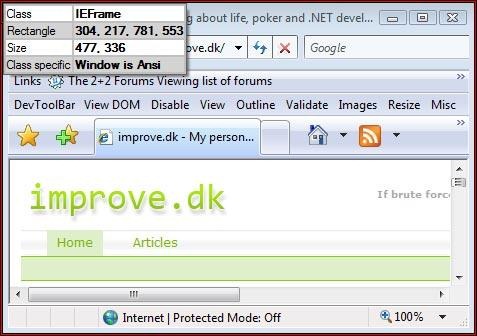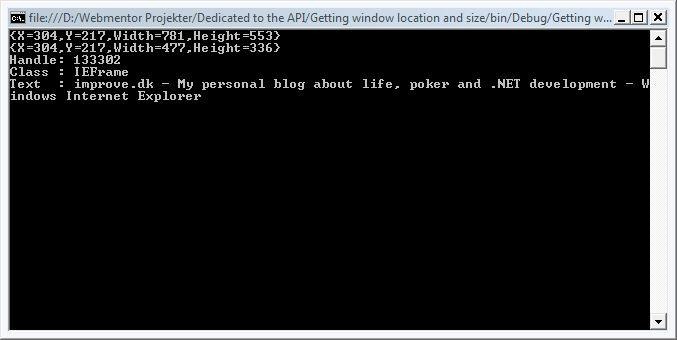Apr
09
2007
This time I’ll show how to obtain the size and location of a window. I will be using the WindowFinder class that I introduced in the blog Finding specific windows.
Note that the location is not in relation to it’s parent windows location, it is always the absolute screen position.
using System.Runtime.InteropServices;
using System.Drawing;
using System.Text.RegularExpressions;
using System;
using System.Text;
using System.Globalization;
namespace Getting_window_location_and_size
{
class Program
{
// Win32 constants.
const int WM_GETTEXT = 0x000D;
const int WM_GETTEXTLENGTH = 0x000E;
// Win32 functions that have all been used in previous blogs.
[DllImport("User32.Dll")]
private static extern void GetClassName(int hWnd, StringBuilder s, int nMaxCount);
[DllImport("User32.dll")]
private static extern Int32 SendMessage(int hWnd, int Msg, int wParam, StringBuilder lParam);
[DllImport("User32.dll")]
private static extern Int32 SendMessage(int hWnd, int Msg, int wParam, int lParam);
// The GetWindowRect function takes a handle to the window as the first parameter. The second parameter
// must include a reference to a Rectangle object. This Rectangle object will then have it's values set
// to the window rectangle properties.
[DllImport("user32.dll")]
public static extern long GetWindowRect(int hWnd, ref Rectangle lpRect);
static void Main(string[] args)
{
// Introduced in the "Finding specific windows" blog, we use the WindowFinder class to find all Internet Explorer main window instances.
Finding_specific_windows.WindowFinder wf = new Finding_specific_windows.WindowFinder();
wf.FindWindows(0, null, new Regex("- (Windows|Microsoft) Internet Explorer"), new Regex("iexplore"), new Finding_specific_windows.WindowFinder.FoundWindowCallback(foundWindow));
Console.Read();
}
static bool foundWindow(int handle)
{
// First we intialize an empty Rectangle object.
Rectangle rect = new Rectangle();
// Then we call the GetWindowRect function, passing in a reference to the rect object.
GetWindowRect(handle, ref rect);
// And then we get the resulting rectangle. The tricky part here is that this rectangle includes
// not only the location of the window, but also the size, but not in the form we're used to.
Console.WriteLine(rect.ToString());
// If the window is 100 x 100 pixels and is located at (10,10), then the rectangle would look like this:
// rect.X = 10;
// rect.Y = 10;
// rect.Width = 110;
// rect.Height = 110;
// We simply have to subtract the rect.X value from the rect.Width value to obtain the "real" width of
// the window, similarly we have to subtract the Y value from the Height value to obtain the real height.
// After this we have the real window properties through the X, Y, Width and Height values.
rect.Width = rect.Width - rect.X;
rect.Height = rect.Height - rect.Y;
// Lets print the rectangle after we've fixed it so we can confirm it's correct.
Console.WriteLine(rect.ToString());
// As used earlier, we print the basic properties of the window.
printWindowInfo(handle);
return true;
}
// Prints basic properties of a window, uses function already used in previous blogs.
private static void printWindowInfo(int handle)
{
// Get the class.
StringBuilder sbClass = new StringBuilder(256);
GetClassName(handle, sbClass, sbClass.Capacity);
// Get the text.
int txtLength = SendMessage(handle, WM_GETTEXTLENGTH, 0, 0);
StringBuilder sbText = new StringBuilder(txtLength + 1);
SendMessage(handle, WM_GETTEXT, sbText.Capacity, sbText);
// Now we can write out the information we have on the window.
Console.WriteLine("Handle: " + handle);
Console.WriteLine("Class : " + sbClass);
Console.WriteLine("Text : " + sbText);
Console.WriteLine();
}
}
}
And the result:
Mark S. Rasmussen

